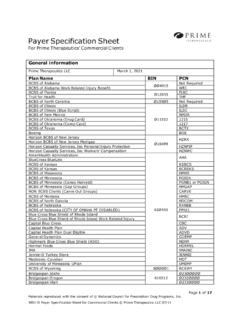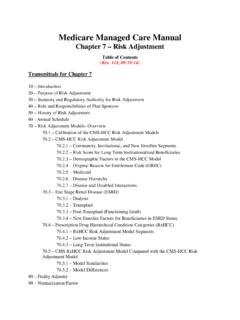Transcription of Menu of State Prescription Drug Identification Laws
1 1 | P a g e Menu of State Prescription Drug Identification Laws The United States is in the midst of an unprecedented epidemic of Prescription drug overdose More than 38,000 people died of drug overdoses in 2010, and most of these deaths (22,134) were caused by overdoses involving Prescription Three-quarters of Prescription drug overdose deaths in 2010 (16,651) involved a Prescription opioid pain reliever (OPR), which is a drug derived from the opium poppy or synthetic versions of it such as oxycodone, hydrocodone, or The Prescription drug overdose epidemic has not affected all states equally, and overdose death rates vary widely across states. States have the primary responsibility to regulate and enforce Prescription drug practices. Although State laws are commonly used to prevent injuries and their benefits have been demonstrated for a variety of injury types,4 there is little information on the effectiveness of State statutes and regulations designed to prevent Prescription drug abuse and By creating an inventory of State legal strategies, this assessment accomplishes the first step in evaluating the effectiveness of Prescription drug Identification laws.
2 Laws that require patients to show personal Identification to pharmacists before receiving Prescription drugs were included in this assessment because of their potential role in decreasing the diversion of controlled Statutes and regulations were included as 1 For the purpose of this document, overdose death refers to death resulting from either intentional overdose or accidental overdose, which could be caused by a patient being given the wrong drug, taking the wrong drug in error, or taking too much of a drug inadvertently. The CDC s Injury Center also refers to overdose as a drug poisoning, which may or may not result in death. 2 Wide-ranging Online Data for Epidemiologic Research (WONDER) Database, Centers for Disease Control and Prevention, [hereinafter WONDER Database 2012]. 3 Id. 4 See, , Schieber, J. Gilchrist & Sleet, Legislative and Regulatory Strategies to Reduce Childhood Injuries, 10 FUTURE CHILD.
3 1, 111 36 (2000). 5 For the purposes of this document, Prescription drug abuse refers to the use of Prescription drugs such as opioid analgesics, sedatives, and stimulants either without a Prescription or for the feeling the drugs can cause. Diversion occurs when Prescription drugs are dispensed, stolen, sold, or given to people who use them for nonmedical reasons. 6 See, , D. Brushwood, Maximizing the Value of Electronic Prescription Monitoring Programs, 31 J. LAW, MED. & ETHICS 1, 41 54 (2003) (noting that the potential for widespread use of forged Identification may undermine Prescription drug monitoring programs and the need for stronger methods to ensure the accuracy of Identification information used in these 2 | P a g e Identification laws only if they expressly State that a pharmacist must or may request Identification before dispensing Prescription Introduction Twenty-five states8 have laws either mandating or allowing pharmacists to request Identification before dispensing Prescription drugs.)
4 All but one of these states has at least one law mandating that the pharmacist request Identification generally or under specific circumstances before dispensing prescriptions. Oregon is the sole State with one Identification law that is entirely By contrast, five states have separate mandatory and discretionary Identification requirements that apply in different situations or to different controlled The permissive laws in these five states grant pharmacists at least some discretion in requesting Identification from patients. The mandatory Identification laws may specify the circumstances under which Identification is required or the drugs to which the requirements apply, the type of Identification required, or whether the pharmacist must record the identifying information. programs).
5 Further note that although this assessment did not examine Prescription monitoring programs because of the related research being done by partner organizations, Identification laws were included because of their potential value in reducing diversion independent of, and beyond, drug monitoring programs. 7 This section includes laws that were enacted prior to June 30, 2013. The first effective dates of the specific provisions referenced are cited as [legal citation] (eff. [year]). Where dates were either not provided within the laws or were unclear due to multiple revisions, this fact is cited as [legal citation] (eff. date unclear, [estimated year]). 8 Connecticut, Delaware, Florida, Georgia, Hawaii, Idaho, Illinois, Indiana, Louisiana, Maine, Massachusetts, Michigan, minnesota , Nevada, New Mexico, New York, North Carolina, North Dakota, Oklahoma, Oregon, South Carolina, Texas, Vermont, Virginia, and West Virginia.
6 See CONN. GEN. STAT. ANN. 20-612a (eff. 2006); 24 DEL. ADMIN. CODE CSA (2009); FLA. STAT. ANN. (eff. 2007); FLA. ADMIN. CODE ANN. r. (eff. 2002); GA. CODE ANN. 26-4-80 (eff. 2011); HAW. REV. STAT. ANN. 329-1 (eff. 1996); HAW. REV. STAT. ANN. 329-41 (eff. 1998); IDAHO ADMIN. CODE. r. (eff. 2008); 720 ILL. COMP. STAT. ANN. 570/312 (eff. 1989); IND. CODE ANN. (b) (eff. 2006); LA. REV. STAT. ANN. 40:971(E) ( ); ME. REV. STAT. ANN. tit. 32, 13786-A(2)(B) (eff. 2003); ME. REV. STAT. ANN. tit. 32, 13795 (eff. 1995); 105 MASS. CODE REGS. (eff. 2010); 105 MASS. CODE REGS. (eff. 2010); 105 MASS. CODE REGS. (eff. 2010); MICH. ADMIN. CODE r. (eff. 2007); MICH. ADMIN. CODE r. (eff. 2007); MINN. STAT. ANN. (eff. 2007); NEV. REV. STAT. ANN. (eff. 2003); NEV. ADMIN. CODE (eff. 2004); CODE R. (eff. 2002); COMP. CODE. R. & REGS. (eff. 2006); COMP. CODE. R. & REGS.
7 (eff. 2006); GEN. STAT. ANN. (eff. 2012); 21 ADMIN. CODE. (eff. 2002); ADMIN. CODE. (eff. 2011); OKLA. STAT. ANN. tit. 63 2-309B (eff. 1990); OKLA. STAT. ANN. tit. 63 2-309C (eff. 1990); OR. ADMIN. R. 855-019-0210 (eff. 2008); CODE ANN. 44-53-360 (eff. 2007); TEX. HEALTH & SAFETY CODE ANN. (eff. 1989); VT. STAT. ANN. tit. 18 4215b (eff. 2013); VA. CODE ANN. (eff. 1905); W. VA. CODE ANN. 60A-3-308 (eff. 2005). Note that reporting requirements (for Prescription monitoring programs or other record requirements ) were not included as Identification laws if they contained only indirect language implying that a pharmacist may check a patient s Identification in order to meet the reporting or recording requirement. Laws were also not included if the Identification requirement applies only to non- Prescription controlled substances. 9 See OR. ADMIN. R. 855-019-0210. 10 Florida, Maine, Nevada, North Carolina, and Virginia.
8 See FLA. ADMIN. CODE ANN. r. (2) (3) (eff. 2002); FLA. STAT. ANN. (2)(d) (eff. 2009); ME. REV. STAT. ANN. tit. 32, 13786-A(2)(B); ME. REV. STAT. ANN. tit. 32, 13795(1); NEV. REV. STAT. ANN. (2); NEV. ADMIN. CODE (1); GEN. STAT. ANN. (a); 21 ADMIN. CODE. (a); VA. CODE ANN. (A), (B). Florida, , specifies five circumstances under which identity verification is mandatory, but leaves it discretionary otherwise.[1] See FLA. ADMIN. CODE ANN. r. (2) (3) (eff. 2002) (requiring Identification under five circumstances); FLA. STAT. ANN. (2)(d) (eff. 2009) (permitting Identification verification). 3 | P a g e Mandatory Identification Laws Of the twenty-four states that have laws mandating that pharmacists check Identification before dispensing, all but one specify the circumstances under which the requirement Delaware s mandatory Identification law is the only one that applies universally, stating that The pharmacist and/or an employee under his/her direct supervision must verify the Identification of the receiver of the controlled substance Prescription by reference to valid photographic Identification , 12 without specifying circumstances under which pharmacists should request Most of the mandatory Identification laws require a dispensing pharmacist to ask for Identification if the person picking up the Prescription is unknown to him or A North Dakota regulation, for example, states, Pharmacists, pharmacy interns, pharmacy technicians.
9 And clerical personnel are required to obtain positive Identification if they are unsure of the identity of the person picking up a Prescription for any controlled substance .. 15 Similarly, an Oklahoma regulation requires Identification when the pharmacist is unsure of the identity of the person picking up the An Idaho law reverses the standard, making an exception to the Identification requirement if the individual receiving the controlled substance is personally and positively known by a pharmac[ist]. 17 Some mandatory Identification laws require dispensers to request Identification under more specific One Maine law, for example, requires pharmacists to request Identification when the 11 Connecticut, Florida, Georgia, Hawaii, Idaho, Illinois, Indiana, Louisiana, Maine, Massachusetts, Michigan, minnesota , Nevada, New Mexico, New York, North Carolina, North Dakota, Oklahoma, South Carolina, Texas, Vermont, Virginia, and West Virginia.
10 See CONN. GEN. STAT. ANN. 20-612a (eff. 2006); FLA. STAT. ANN. (eff. 2007); FLA. ADMIN. CODE ANN. r. (eff. 2002); GA. CODE ANN. 26-4-80 (eff. 2011); HAW. REV. STAT. ANN. 329-1 (eff. 1996); HAW. REV. STAT. ANN. 329-41 (eff. 1998); IDAHO ADMIN. CODE. r. (eff. 2008); 720 ILL. COMP. STAT. ANN. 570/312 (eff. 1989); IND. CODE ANN. (b) (eff. 2006); LA. REV. STAT. ANN. 40:971(E) ( ); ME. REV. STAT. ANN. tit. 32, 13786-A(2)(B) (eff. 2003); ME. REV. STAT. ANN. tit. 32, 13795 (eff. 1995); 105 MASS. CODE REGS. (eff. 2010); 105 MASS. CODE REGS. (eff. 2010); 105 MASS. CODE REGS. (eff. 2010); MICH. ADMIN. CODE r. (eff. 2007); MICH. ADMIN. CODE r. (eff. 2007); MINN. STAT. ANN. (eff. 2007); NEV. REV. STAT. ANN. (eff. 2003); NEV. ADMIN. CODE (eff. 2004); CODE R. (eff. 2002); COMP. CODE. R. & REGS. (eff. 2006); COMP. CODE. R. & REGS. (eff. 2006); GEN. STAT. ANN.













